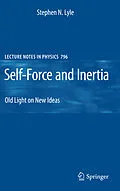The vast majority of particles in particle physics are today considered to be bound states of other particles. All forms of binding energy and kinetic energy in such a state have to be included in its inertial mass. This book revives the classical explanation for this in the case of electromagnetic interactions. But it is also a reminder of the many benefits of this classical understanding that are simply dropped in modern accounts of inertia. This is a book for the motivated student who feels it is useful to remember where our theories come from. There is also a comprehensive overview of the state of the art in particle physics.
Autorentext
www.stephenlyle.org
Klappentext
Any student working with the celebrated Feynman Lectures will ?nd a chapter in it with the intriguing title Electromagnetic Mass [2, Chap. 28]. In a way, it looks rather out of date, and it would be easy to skate over it, or even just skip it. And yet all bound state particles we know of today have electromagnetic mass. It is just that we approach the question differently. Today we have multiplets of mesons or baryons, and we have colour symmetry, and broken ?avour symmetry, and we think about mass and energy through Hamiltonians. This book is an invitation to look at all these modern ideas with the help of an old light. Everything here is quite standard theory, in fact, classical electromagnetism for the main part. The reader would be expected to have encountered the theory of elec tromagnetism before, but there is a review of all the necessary results, and nothing sophisticated about the calculations. The reader could be any student of physics, or any physicist, but someone who would like to know more about inertia, and the clas sical precursor of mass renormalisation in quantum ?eld theory. In short, someone who feels it worthwhile to ask why F= ma.
Inhalt
Introduction and Guide.- Some Notions of Electromagnetism.- Electromagnetic Mass.- A Brief Excursion into General Relativity.- Momentum and Energy in the EM Fields of a Charge Dumbbell.- Self-Force for Transverse Linear Acceleration.- Self-Force for Axial Linear Acceleration.- Self-Force for Transverse Rotational Motion.- Self-Force for Longitudinal Rotational Motion.-Summary of Results.- Reconciling Energy- and Momentum-Derived EM Masses.-Rigidity in Relativity.- Mass in Elementary Particle Physics.- Summary and Conclusion.- References.-
